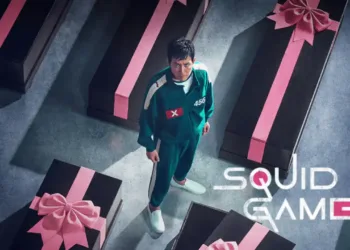This third installment of the wholesome teen romance offers plenty of warmth and feels profoundly relatable in its exploration of heavy yet honest themes. Viewers first met the love story between Charlie Spring and Nick Nelson back in Season 1, which rapidly had us rooting for these adorable schoolmates.
Their chemistry shone so brightly that it was easy to get attached to their burgeoning feelings despite their initial uncertainty. Season 2 took us alongside the pair on vacation as they grew closer, though many storylines were left on a cliffhanger.
Now in Season 3 of the Netflix series adaptation of Alice Oseman’s graphic novels, we catch up with Charlie, Nick, and their endearing friends in the aftermath of senior prom, facing new challenges together. While Nick and Charlie remain elated in their relationship, cracks begin to show in Charlie’s mental well-being that threaten to spiral.
Elsewhere in their circle, other characters must wrestle with identity, independence, and intimacy in ways familiar yet unique to each individual. Oseman skillfully balances empathy and truth in her portrayals, giving glimpses into diverse experiences through a compassionate lens.
Early episodes establish the season’s tone with sensitivity, in particular focusing on Charlie’s struggles with anorexia and his decision to seek treatment. Other key storylines include Elle dealing with dysphoria and transphobia, Tara’s academic anxiety impacting her wellness, and various characters navigating sexual discovery. Fans will be enthralled by how Heartstopper blooms yet again in Season 3 through grounded sincerity and a bittersweet summer that audiences won’t soon forget.
Heart and Soul
These characters feel like family after three heartwarming seasons, so it’s no surprise relationships remain at the story’s core. Nick and Charlie pick back up in the summer glow of new love, but dark clouds loom over Charlie’s wellbeing.
Their bond faces tough tests as Charlie’s eating disorder spirals and he seeks treatment far from home. Although it pains them to be apart, Nick’s supportive presence encourages Charlie throughout his difficult recovery journey.
Elsewhere, Tao stands by Elle’s side as she experiences painful dysphoria and hurtful prejudice. Finney brings profound empathy to these scenes, sharing an authentic glimpse of the transgender experience. Tara navigates independence while caring for girlfriend Darcy, now homeless. And Isaac feels left out as friends pair off, finding solidarity in his asexual identity.
Oseman captures relatable moments that feel ripped from reality. Tao comforts Elle after a radio host’s cruel remarks spark painful memories. Later, Nick comforts a weeping Charlie, scared he’ll never feel normal in his body again. Their raw emotions resonate with anyone struggling with insecurity. Behind amusing anecdotes lie hardships these teens support each other through, reminding audiences we all experience vulnerability at their age.
Above all, Heartstopper celebrates embracing yourself completely. Whether exploring attractions, gender, or mental wellness, characters accept themselves and each other unconditionally. Their found family offers a shoulder to lean on and safe space to be your full self. These heartwarming relationships remind viewers that love and compassion will always triumph over prejudice.
Bonding Over Being
Heartstopper prides itself on exploring universal human experiences through an empathic lens. Unsurprisingly then, relationships lie at the story’s heart—between partners managing the trials of blossoming intimacy, within family as they learn to understand delicate struggles, and among friends who offer unconditional care.
Above all, consent and communication prove paramount. We see Charlie and Nick steadily building trust through open dialogue, navigating quandaries of the mind, body, and spirit together rather than apart. Elsewhere, Tori’s stoic yet caring bond with Charlie highlights familial challenges to accepting hardships beyond our control.
Moreover, portraying the intricate mosaic of mental health proves a signature strength. Subtle yet striking depictions shed light on facing anxieties, disorders, and more and seeking help, normalizing discussions so desperately needing air time.
Just as nuanced, various arcs also represent fluid identities with sensitivity. From orientations to labels, characters navigate self-understanding, showing queer audiences themselves at every turn. Regardless of where one’s journey leads, found families prove pillars of solidarity.
Overall, Heartstopper emerges as a guiding light through shared vulnerabilities. By embracing our innate connectedness beyond surfaces, it reminds us that understanding and compassion shall forever conquer prejudice. Bonds strengthen when we uphold each person’s intricate humanity above all else.
Blossoming Talent on Screen
Heartstopper’s ensemble ensures the emotional beats land with grace thanks to gifted performances at its core. Joe Locke brings soul-baring honesty to Charlie, whose vulnerabilities and perseverance in facing mental strife feel piercingly authentic. Alongside him, Kit Connor subtly carries Nick’s quiet resilience, a pillar bolstering their relationship during testing times.
Their magnetic chemistry anchors the series, effortlessly conveying youthful romance and compassion as their bond matures through open communication. When anxieties arise, Nick’s steadfast care reminds him that help comes in many forms. Their bond feels reminiscent of relationships destined to outlast teenage tribulations.
Yasmin Finney likewise shines as Elle, portraying gender dysphoria and trans prejudice with empathy drawn from lived understanding. From discomforting radio segments to intimate moments questioning identity alongside Tao, she taps poignancy within each scene. Finney emerges as not only a talent to watch but a guiding light for accurate minority representation.
Heartstopper wouldn’t resonate without its vibrant supporting players. Corinna Brown and Jenny Walser lend heart and humor as Tara and Tori, balancing the stories with grounded sisterly care. William Gao and Tobie Donovan imbue Tao and Isaac with nuanced humanity beyond brief depictions. Each actor blossoms into multi-faceted individuals whose arcs nourish the series’ beating heart.
While relationships take center stage, Oseman ensures no character feels one-note. Their blossoming talent ensures even the most challenging issues feel explored with empathy, inviting audiences into their lives, hopes, and hardships. In them, viewers witness reflections of our shared capacity for both fragility and strength.
Musical Moods and Visual Verve
With Andy Newberry at the helm this season, Heartstopper adopts a fresher feel through novel visual and aural approaches that enhance beloved characters. Following Euros Lyn’s poetic spirit, Newberry paints relatable realism while maintaining that signature sunshine.
Color palettes remain vibrant yet grounded, buoying bittersweet beats through costume and location choices. France glows in youthful adventure, summer sun-drenched bliss contrasting hospital sterility during dark moments. Animation bursts transport internally, underscoring turbulence beneath surfaces.
Most striking though is the music. Track selections feel curated to lift specific scenes to new emotive planes, whether indie anthems rally teens’ bravery or solitary strings accompany lonely musings. Songs cloak interactions in deeper understanding through shared cultural touchpoints.
Heartstopper thrives through its artful, empathetic spirit. Newbery and crew craft snapshots destined to linger in memory, ensuring the journey resonates beyond final frames. Their techniques wed entertainment with enlightenment, reminding us that creativity holds the power to start important dialogues and nurture compassion. Through stirring scores and visual magic, this season blooms with humanity.
Hearts and Homes United
The popularity of Heartstopper speaks volumes about representation meaningfully weaving minorities into storytelling. With care and insight, it spotlights queer journeys in all their humanity, reflecting back to viewers their intrinsic beauty and complexity.
Unsurprisingly, then, found families form at the series’ core. For LGBT youth unsure of where they belong, its themes ring true on a profoundly personal level. Seeing mirrored one’s very real doubts, hopes, and loves nourishes the soul like little else. Suddenly they feel understood in a world not always so forgiving.
Yet Heartstopper connects far beyond any single label. Its teens face isolation, unsteadiness, and self-discovery—struggles familiar to all. By emphasizing our shared capacity for both weakness and resilience, distance collapses between characters and viewers alike. Bonds form through celebration of our inherent kinship beyond surfaces.
In such divisive times, its gentle reminder proves cathartic—that understanding and compassion can overcome prejudice in daily life. As discussions sparked by its grounded authenticity foster empathy globally, Heartstopper emerges a beacon of light, love, and home for those needing it most.
Heartstopper’s Humane Journey Home
In summarizing an outstanding third season, it’s clear that Heartstopper evolves in all the right ways. While retaining the empathetic tone drawing fans in, increased depth affords new layers of meaning with each rewatch. Issues addressed feel poignant and prompt refreshingly thoughtful dialog.
Above all, this season celebrates queer lives authentically through tender yet truthful narratives. Mental health, identity, and intimacy face thoughtful portrayals recognizing life’s complexities without loss of hope. Supported by stunning performances and direction, hardships feel grounded yet surmountable.
Most remarkable is maintaining purity of spirit even venturing into mature terrain. Rather than scandalize, intimacy remains beautiful in prioritizing care, trust, and self-acceptance. This resonates profoundly for anyone facing vulnerabilities within relationships.
After such a stirring installment, anticipation runs high for where these characters’ journeys lead. While bittersweet to reach the finale, few shows feel like such an embrace. Heartstopper reminds us that love, communication, and community empower people to walk taller amid today’s challenges. Its humanity sees the light guiding teenagers home once more.
The Review
Heartstopper Season 3
In tenderly portraying adolescence in all its complexity, Heartstopper emerges as a shining beacon of empathy, eliciting both laughter and tears through its vibrant ensemble. Never abandoning integrity, each season has blossomed forth with greater emotional density yet retains that buoyant spirit, which makes revisiting its richly drawn characters and their sunny adventures feel like a warm hug. Although parting may prove bittersweet when all is said and done, few shows leave such a heartwarming glow or feel better fitted to instill hope for a brighter tomorrow.
PROS
- Sensitive and authentic portrayals of mental health, sexuality, and identity issues
- Heartwarming, wholesome dynamic between the main couple and their friends
- Strong, likable characters with meaningful story arc development
- Visual aesthetics and music enhance the emotional tone and themes.
- Promotes empathy, compassion, and LGBTQ+ representation
CONS
- Some character subplots feel less developed or sudden compared to others.
- Occasional predictability or clichés in teen drama tropes
- Temporary cliffhangers leave viewers eagerly awaiting next season releases.





















































